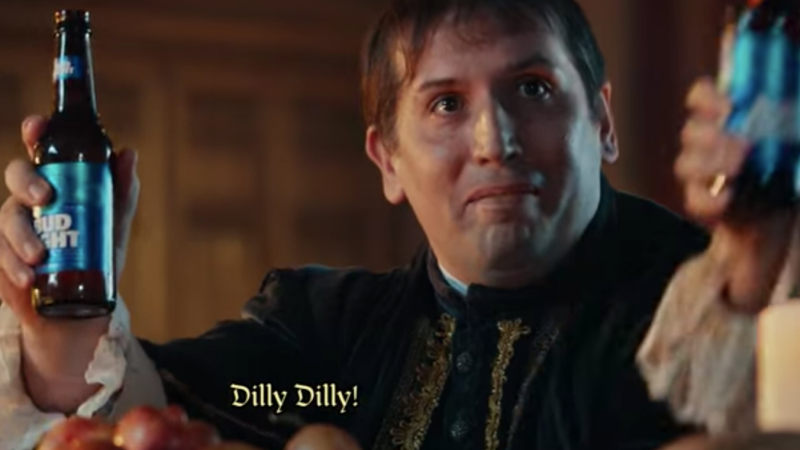If you have a television or follow football, you most likely haven’t been able to escape “Dilly Dilly.”
Bud Light’s humor-based campaign kicked off in August with a "Game of Thrones"-inspired TV spot and has since followed up with four additional ads. The catchphrase has become part of the pop-culture vocabulary, uttered everywhere from the line of scrimmage during an NFL game to the floor of the Indiana Senate to the halls of Merriam-Webster (which acknowledged recently it’s monitoring the phrase).
Indeed, some already are making comparisons to the 1999 Budweiser “Whassup?!” campaign.
The problem for Anheuser-Busch with that comparison, of course, is that while “Whassup?!” moved through the zeitgeist, it didn’t move cases of beer. And so far neither has “Dilly Dilly.”
The nation’s largest beer brand suffered its biggest annual volume decline ever in 2017, dropping 5.7 percent, according to Beer Marketer’s Insights (subscription required). It lost 0.8 percentage points of market share, settling at 15.4 percent.
In the most recent four-week period, Bud Light volume was down 6.8 percent, according to Nielsen data through Jan. 13. (Coors Light volume was down 3 percent and Miller Lite volume was down 0.6 percent during the same period.)
Budweiser has fared even worse. Sales of the brand, which have declined each year since 1988, were down 6.8 percent in 2017, according to BMI. That was enough for Miller Lite to leapfrog Bud to become the No. 3 beer in the U.S.
Bud Light’s slide, meanwhile, started in 2008. In order to climb out of this rut, A-B brought back Andy Goeler, an energetic marketer who worked on Bud Light during its heyday (he was involved with the “Real Men of Genius” campaign) and since coming back to the brand has helped hatch “Dilly Dilly.”
He says it’s catching on. In interviews with Beer Business Daily (subscription required,) Goeler says there are now more than 300,000 Google searches for “Dilly Dilly,” the #DillyDilly hashtag has been used more than 66,000 times on Instagram and Bud Light has seen a 6 percent improvement in share of organic social media mentions within the beer segment.
An Anheuser-Busch spokesman declined to comment on Bud Light’s trajectory, but noted that the company plans Super Bowl television spots featuring Bud Light, Budweiser, Michelob Ultra and Stella Artois.
When asked by Beer Business Daily for evidence that the campaign is helping sales, Goeler laid out the brand’s approach: "Step one is trying to get people's attention back on Bud Light.” Step two is “getting it into people's hands.” As 2018 wears on, Goeler said, Bud Light is “very focused” on converting all the talk about the brand and “Dilly Dilly” into sales, BBD wrote.
Beer Marketers Insights asked Goeler in December if the “Dilly Dilly” campaign was showing up in sales scans. That time, he “pointed to (Florida) where Bud Light had (its) best share trend in 16 (months) in (November,)” according to the publication.
Bud Light volume share trends did improve by 0.4 percentage points in Florida between summer and the end of 2017, per Nielsen multi-channel data. But it’s not clear whether that was due to “Dilly Dilly” or a different lever: pricing.
During the summer, price gaps narrowed between Michelob Ultra and Bud Light in Florida, according to Nielsen. Given that Michelob Ultra has been shown to source volume from Bud Light, that may have induced some loyalists of the company’s biggest beer brand to switch. But as that price gap widened by $1.66 after the summer months, Michelob Ultra share growth slowed by 0.4 points.
Indeed, a MillerCoors analysis of Nielsen data for 37 state markets found that 73 percent of them saw gaps widen between the two brands during that same period. In 59 percent of the markets where gaps widened, Bud Light share trends improved while Michelob Ultra’s decelerated.
(MillerCoors looked at data comparing the 13 weeks ending Aug. 26 to the 13 weeks ending Dec. 30.)
So while Anheuser-Busch has been able to sell “Dilly Dilly,” it remains unclear whether that alone will be enough to sell more Bud Light.

